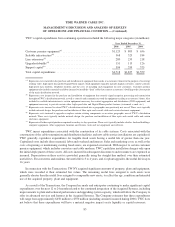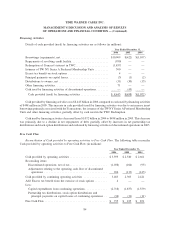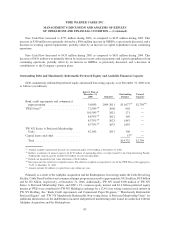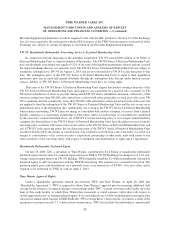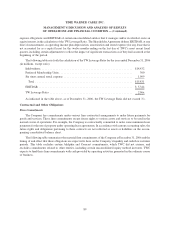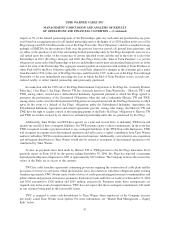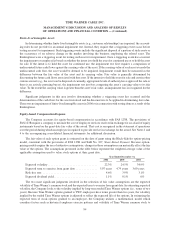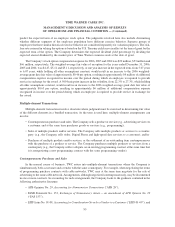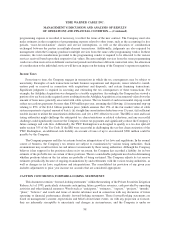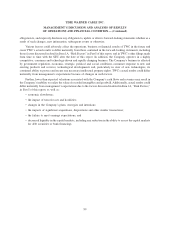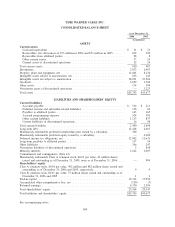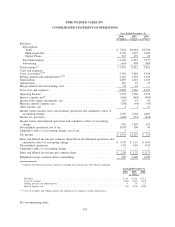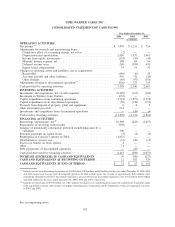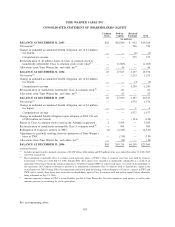Time Warner Cable 2006 Annual Report Download - page 98
Download and view the complete annual report
Please find page 98 of the 2006 Time Warner Cable annual report below. You can navigate through the pages in the report by either clicking on the pages listed below, or by using the keyword search tool below to find specific information within the annual report.development and selection of these critical accounting policies have been determined by the management of TWC
and the related disclosures have been reviewed with the audit committee of the board of directors of TWC. For a
summary of all of the Company’s significant accounting policies, see Note 2 to the accompanying consolidated
financial statements.
Asset Impairments
Goodwill and Indefinite-lived Intangible Assets
Goodwill impairment is determined using a two-step process. The first step of the goodwill impairment test is
to identify a potential impairment by comparing the fair value of a reporting unit with its carrying amount, including
goodwill. The Company has identified six reporting units based on the geographic locations of its systems. The
estimates of fair value of a reporting unit are determined using various valuation techniques, with the primary
technique being a discounted cash flow analysis. A discounted cash flow analysis requires one to make various
judgmental assumptions including assumptions about future cash flows, growth rates and discount rates. The
assumptions about future cash flows and growth rates are based on TWC’s budget and business plan and
assumptions are made about the perpetual growth rate for periods beyond the long-term business plan period.
Discount rate assumptions are based on an assessment of the risk inherent in the future cash flows of the respective
reporting units. In estimating the fair values of its reporting units, the Company also uses research analyst estimates,
as well as comparable market analyses. If the fair value of a reporting unit exceeds its carrying amount, goodwill of
the reporting unit is not deemed to be impaired and the second step of the impairment test is not performed. If the
carrying amount of a reporting unit exceeds its fair value, the second step of the goodwill impairment test is
performed to measure the amount of impairment loss, if any. The second step of the goodwill impairment test
compares the implied fair value of the reporting unit’s goodwill with the carrying amount of that goodwill. If the
carrying amount of the reporting unit’s goodwill exceeds the implied fair value of that goodwill, an impairment loss
is recognized in an amount equal to that excess. The implied fair value of goodwill is determined in the same manner
as the amount of goodwill recognized in a business combination. In other words, the fair value of the reporting unit
is allocated to all of the assets and liabilities of that unit (including any unrecognized intangible assets) as if the
reporting unit had been acquired in a business combination and the fair value of the reporting unit was the purchase
price paid to acquire the reporting unit.
The impairment test for other intangible assets not subject to amortization consists of a comparison of the fair
value of the intangible asset with its carrying value. The Company has identified six units of accounting based upon
geographic locations of its systems in performing its testing. If the carrying value of the intangible asset exceeds its
fair value, an impairment loss is recognized in an amount equal to that excess. The estimates of fair value of
intangible assets not subject to amortization are determined using various discounted cash flow valuation
methodologies. The methodology used to value the cable franchises entails identifying the projected discrete
cash flows related to such franchises and discounting them back to the valuation date. Significant assumptions
inherent in the methodologies employed include estimates of discount rates. Discount rate assumptions are based on
an assessment of the risk inherent in the respective intangible assets.
TWC’s 2006 annual impairment analysis, which was performed during the fourth quarter, did not result in an
impairment charge. For one reporting unit, the 2006 estimated fair value was within 10% of the respective book
value. Applying a hypothetical 10% decrease to the fair value of this reporting unit would result in a greater book
value than fair value for cable franchises in the amount of approximately $20 million. Other intangible assets not
subject to amortization are tested for impairment annually, or more frequently if events or circumstances indicate
that the asset might be impaired.
93
TIME WARNER CABLE INC.
MANAGEMENT’S DISCUSSION AND ANALYSIS OF RESULTS
OF OPERATIONS AND FINANCIAL CONDITION — (Continued)


